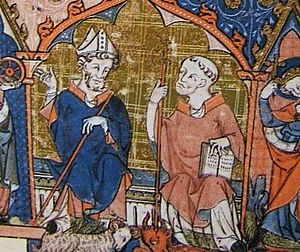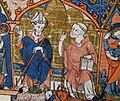Eadnoth the Younger facts for kids
Quick facts for kids Eadnoth |
|
|---|---|
| Bishop of Dorchester | |

Miniature of a bishop and an abbot from the 14th-century Ramsey Psalter, thought to be Oswald (left) and his kinsman Eadnoth (right)
|
|
| Province | Canterbury |
| Diocese | Dorchester |
| Enthroned | Between 1007 and 1009 |
| Reign ended | 1016 |
| Predecessor | Ælfhelm |
| Successor | Æthelric |
| Other posts | Previously Abbot of Ramsey (c. 992—1007 x 1009) |
| Personal details | |
| Parents | Æthelstan Mannessune and unknown (kinswoman of Archbishop Oswald) |
| Profession | Monk |
| Sainthood | |
| Feast day | 18 October |
| Patronage | Ramsey Abbey |
| Shrines | Ely Cathedral (medieval) |
| Cult suppressed | See Dissolution of the Monasteries |
Eadnoth the Younger was an important religious leader in medieval England. He was first a monk, then an Abbot (head of a monastery), and finally a Bishop (a high-ranking church official).
Eadnoth came from a well-known family of priests in a marshy area called the Fens. He was related to Oswald, who was a bishop and an archbishop, and who also started Ramsey Abbey. Eadnoth followed in Oswald's footsteps, becoming a monk at Worcester.
Around the year 992, Eadnoth became the Abbot of Ramsey Abbey. While he was abbot, he started two new religious houses. One was a monastery for monks at St Ives, and the other was a nunnery for nuns at Chatteris.
Later, between 1007 and 1009, Eadnoth became the Bishop of Dorchester. This was a very large area that covered much of eastern England, known as the Danelaw. Eadnoth died in 1016 during a battle called the Battle of Assandun, fighting against Cnut the Great.
Contents
Eadnoth's Family and Early Life
Eadnoth the Younger was the son of a man named Æthelstan Mannessune. His mother was a relative of Bishop Oswald. Eadnoth's father's family were priests from the Isle of Ely area. They owned land in several places, including Cambridgeshire and Huntingdonshire.
Eadnoth was called "the Younger" to tell him apart from another Eadnoth. This other Eadnoth, called "the Elder," was a follower of Oswald and worked at Ramsey Abbey before Eadnoth the Younger became abbot.
Eadnoth the Younger had a brother named Godric and at least two sisters, Ælfwaru and Ælfwyn. His brother and sisters inherited land from their father. However, Eadnoth became a monk at Worcester Abbey. Because he was a monk, he could not inherit property.
Eadnoth first appears in records in the 980s. He was helping to supervise repairs on the western tower of Ramsey Abbey. He likely took over duties from Eadnoth the Elder around 991 or earlier. He officially became Abbot of Ramsey in 992.
Becoming Abbot of Ramsey Abbey
The book Liber Benefactorum, which tells the history of Ramsey Abbey, calls Eadnoth the "first abbot of Ramsey." It says that the monks of Ramsey chose him according to the Benedictine Rule. This rule was a set of guidelines for how monks should live.
Before Eadnoth, Ramsey Abbey had two groups of monks. One group had been moved there by Oswald in the 960s. The other group had come from Winchcombe in the 980s because of problems with monasteries in Mercia. Oswald had been the head of the first group, and a monk named Germanus was the head of the Winchcombe monks.
Historians believe that Eadnoth became abbot because of Oswald's influence. Even though it was not common to get such a high position through family connections at that time, Oswald himself had also risen in power because of his family.
As abbot, Eadnoth started a nunnery on his family's land at Chatteris. His younger sister, Ælfwyn, became the first head of this nunnery. In 1007, the Chatteris nunnery received more land after the death of Eadnoth's other sister, Ælfwaru.
Eadnoth also founded a monastery at St Ives, Cambridgeshire. This new monastery, like Chatteris, was connected to Ramsey Abbey. It received land that had belonged to Eadnoth's father. On April 24, 1002, Eadnoth moved the bones of Saint Ivo to Ramsey Abbey. Saint Ivo was the saint after whom St Ives was named. His bones had been found by a farmer a year earlier.
Eadnoth as Bishop of Dorchester
Sometime between 1007 and 1009, Eadnoth became the Bishop of Dorchester. The Dorchester diocese was very large. It was based far to the south in Dorchester on Thames, but it covered much of the eastern Danelaw. This area was roughly the same as the old diocese of Leicester. Later, it also included the Diocese of Lindsey. In later years, the bishop's main church moved north and became the well-known bishopric of Lincoln.
We don't know much about Eadnoth's time as bishop. He first appears as a bishop in a document from 1009. This document was issued by King Æthelred. Eadnoth signed at least eight more royal documents before he died.
On October 18, 1016, Bishop Eadnoth fought and was killed at the Battle of Assandun in Essex. He died alongside Wulfsifge, who was the new abbot of Ramsey, and Æthelweard, a son of Ealdorman Æthelwine. Eadnoth was fighting for Edmund Ironside against Cnut, a Danish invader who wanted to become the King of England.
After his death, Eadnoth's body was taken north towards Ramsey Abbey. However, a group of people led by Ælfgar attacked the group carrying his body. Eadnoth's body then stayed at Ely Cathedral. There, he was honored as a saint and became known as Eadnoth the Martyr.
It is believed that Abbot Eadnoth is shown in a picture from a 14th-century book called the Ramsey Psalter. He is shown next to a bishop, who is thought to be his relative, Bishop Oswald. Below Oswald is a ram, which represents the name Ramsey. Below Eadnoth is a bull, which relates to a story about how Ramsey Abbey was founded.
Images for kids


